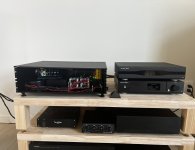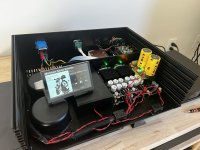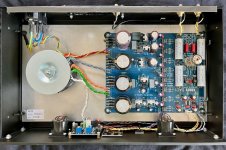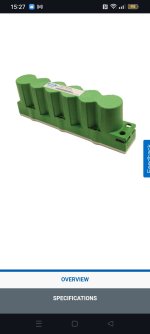That is right. This is how things should be. However, we are struggling with in-between posts from some members feeling the urge to publish comments even though they have very little experience to share on the subject of this thread.The people who succeeded in getting things to works should share ideas how to improve things with other people having working stacks.
Hello Simon,
So you are the one who instigates all these updates?
I think most problems arise after the stacks are finished and everybody will try to make it work with another dac , power supplies in the attic or all kinds of" software/ operating system" which all seem to require a little bit of sudoku to get it working.
Ian could hire Gabster to make some tutorials of the few stacks that people will usually build.
If i am right i never see an actual build with a Raspberry physically separated from the other boards as the Italian competitor always suggested to do.
Greetings Eduard
So you are the one who instigates all these updates?
I think most problems arise after the stacks are finished and everybody will try to make it work with another dac , power supplies in the attic or all kinds of" software/ operating system" which all seem to require a little bit of sudoku to get it working.
Ian could hire Gabster to make some tutorials of the few stacks that people will usually build.
If i am right i never see an actual build with a Raspberry physically separated from the other boards as the Italian competitor always suggested to do.
Greetings Eduard
@eduard
I don’t think you would know what you are looking at period due to having zero experience with these builds.
Come back when you can afford to actually do one yourself. Until then….
buzz off.
I don’t think you would know what you are looking at period due to having zero experience with these builds.
Come back when you can afford to actually do one yourself. Until then….
buzz off.
Man you have a lot of thoughts but geez, get the memo already....I think most problems arise after the stacks are finished and everybody will try to make it work with another dac , power supplies in the attic or all kinds of" software/ operating system" which all seem to require a little bit of sudoku to get it working...
Remember that guy in early 90s? The one calling tech support about modem with flashing lights who used the PC CD tray as a cup holder?
Yup, That's @eduard 🤣🤣


Just a little update.
Been burning my build in for the past 3days. Sound just keeps getting better and better.
I’m using the Audiophonics Dac hat, upsampling to 384k, true sync mode with the AS338 clocks.
For PCM playback, I’m a bit of a technically accurate audiophile, I so listening now with the Linear Fast Roll-Off filter for good frequency extension, sharp roll-off, minimal ultrasonic imaging, and linear phase (best temporal performance without phase shift).
It has surpassed my Gustard A26 in pcm SQ.
Because the Dac has no NOS mode testing DSD I feel won’t be fair fight.
Next is to finish up the face plate and flush mount the 5in screen.
Huge thanks to you all! Successful build for a complete newb!
Been burning my build in for the past 3days. Sound just keeps getting better and better.
I’m using the Audiophonics Dac hat, upsampling to 384k, true sync mode with the AS338 clocks.
For PCM playback, I’m a bit of a technically accurate audiophile, I so listening now with the Linear Fast Roll-Off filter for good frequency extension, sharp roll-off, minimal ultrasonic imaging, and linear phase (best temporal performance without phase shift).
It has surpassed my Gustard A26 in pcm SQ.
Because the Dac has no NOS mode testing DSD I feel won’t be fair fight.
Next is to finish up the face plate and flush mount the 5in screen.
Huge thanks to you all! Successful build for a complete newb!
Attachments
Many in here have tried Ian Canada stuff with other DACs. Myself, I have used it with at least 8 different DACs. And have tested different types of power supplies and played with all kinds of software.I think most problems arise after the stacks are finished and everybody will try to make it work with another dac , power supplies in the attic or all kinds of" software/ operating system" which all seem to require a little bit of sudoku to get it working.
If i am right i never see an actual build with a Raspberry physically separated from the other boards as the Italian competitor always suggested to do.
That is not correct. Several have presented their builds with RPi separated including the build I have shared.
You should read the thread before commenting and misleading others.
If you don't want to read it. Please restrain yourself from making more mess than help on this forum.
@camrector Very nice build, clean layout. Congrats! Had a similar experience with Gustard A26. Actually sold it now 🙂
That is not correct. Several have presented their builds with RPi separated including the build I have shared.
Can you share some post numbers?
Greetings, Eduard
Can you share some post numbers?
Greetings, Eduard
@Spacejack thanks man!!
I was hoping that this dac/streamer at least was on par with the A26. It has for sure surpassed it.
I was building the Ian Canada for a secondary system and now it looks like it’s staying in the main one lol.
I was hoping that this dac/streamer at least was on par with the A26. It has for sure surpassed it.
I was building the Ian Canada for a secondary system and now it looks like it’s staying in the main one lol.
I'd start with post one and read through. By the time you catch up you may have learned something.That is not correct. Several have presented their builds with RPi separated including the build I have shared.
Can you share some post numbers?
Greetings, Eduard
Great build👍 and the getting better has only just begun,Just a little update.
Been burning my build in for the past 3days. Sound just keeps getting better and better.
I’m using the Audiophonics Dac hat, upsampling to 384k, true sync mode with the AS338 clocks.
For PCM playback, I’m a bit of a technically accurate audiophile, I so listening now with the Linear Fast Roll-Off filter for good frequency extension, sharp roll-off, minimal ultrasonic imaging, and linear phase (best temporal performance without phase shift).
It has surpassed my Gustard A26 in pcm SQ.
Because the Dac has no NOS mode testing DSD I feel won’t be fair fight.
Next is to finish up the face plate and flush mount the 5in screen.
Huge thanks to you all! Successful build for a complete newb!
Last edited:
Just to edit my above post. I’m using the Audiophonics dac hat software on Ropieee.
The dac hat Im using is the Ian Canada dual mono ess.
The dac hat Im using is the Ian Canada dual mono ess.
Strangely, you asked for that, @eduard, since your posts are all over and between the relevant posts.That is not correct. Several have presented their builds with RPi separated including the build I have shared.
Can you share some post numbers?
Greetings, Eduard
Maybe you should spend more time reading with understanding rather than repeatedly posting about the resistance of green terminals, the use of TentLabs shunt regulators instead of coke can size caps, and then how noisy TentLabs could be since the designer of dddac decided to stop using them.
Ian himself has several times mentioned isolating RPi from the main stack:
Example 1 Example 2 Example 3 Example 4
There are several documented builds following this concept, for instance
and more.
Please focus on understanding what is published here @eduard before you grace the readers with your insights.
Hey Edward,Hello Simon,
So you are the one who instigates all these updates?
I think most problems arise after the stacks are finished and everybody will try to make it work with another dac , power supplies in the attic or all kinds of" software/ operating system" which all seem to require a little bit of sudoku to get it working.
Ian could hire Gabster to make some tutorials of the few stacks that people will usually build.
If i am right i never see an actual build with a Raspberry physically separated from the other boards as the Italian competitor always suggested to do.
Greetings Eduard
Of course not, Ian decides what he wants to update and when as his hobby. Its great too see he improves his modules and gives us the option to purchase or not, we all have choices right.
Ian could do many things but who are we to state what he should do?
Those are not problems, those are diy members tweaking and playing with this hobby and Ian cant cover all the scerious and posisble combinations out there. If people chose to "play" they need to understand just that and not expect a manual to tell them how to actually do it.
Think back to the DDDAC, huge amount of people experimented and tweaked the DAC as they had the ability and wanted too. Doede saw these great mods and added some of them to his updated design. This is the fun of this great hobby.
Anyway, my views and I will leave it there......enjoy 😉
... how noisy TentLabs could be since the designer of dddac decided to stop using them....
Just to set this in the right context. Tent Shunts are not particularly noisy and even so, that was not the only reason I decided to use another regulation solution in the DDDAC1794 MK3. Second reason was output impedance at low frequency.
I still personally believe that the Tentshunts are one of the best and easiest upgrades for the 78xx series in general, and in specific on the DDDAC Mainboard (PBT series)
By the way, before someone asks... The also widely used LT3045, measures superbly on both aspects as well. But somehow it never convinced me to be the winner in both digital and analog sections. I did several A-B listening tests on several different pcs of equipment with all kind of counter players. At the end I always came up with Tent Shunts and now my OOTB solution. Measures also good, but more important, it just has that extra uptick, sonically spoken.
Last edited:
Hi , Not really compared it with any professional , expensive , overpriced dacs, just my old Pioneer N50 network streamer , and a old Meridian 506/20 CD player. And it was better, for about $50 it is well worth it, no need to hesitate; Although , I did add better components as recomended. I see that @Gabster 2000 answered your question about volume levels , so i will leave it at that.Which DACs have you favorably compared ProtoDAC with?
In terms of Enjoyment here is how I rate my own system: (based on FTPM --> foot taps per minute)
1) Turntable : best
2) ProtoDac With Tube Buffer
3) Meridian 506/20
4) ProtoDac
5) Pioneer N50
@Ras Dan I happen to have a quite nice R2R DAC, based on eight TDA1453 chips. I drive that DAC via a S/PDIF cable connected to my recently constructed Ian Canada flagship streamer (with FifoPi Q7 and TransportPi AES). So, I am just wondering whether the ProtoDAC would be comparable to my current DAC (which I doubt, to be honest). The only way to know is to try, but then again is it worth spending even a small amount of money for something that might be put aside right away?
Attachments
Last edited:
Hello,
I referred to the post of the Master himself a few times in the last few months where he states that using the " HDMI solution" is the best way to go isolate the Raspberry from the sensitive boards. In fact he claims it is so good you can start using a very basic supply because the noise " generated" by the Raspberry has no path to get into your precious items.
But you decided to ditch the HDMI related boards and connect the parts like one would do in a diy desktop so then it becomes a bit misty.
If one is so concerned about ESR the green connectors are just not that good. In the attachment you can see one of the supercaps i am using which has M5 screw terminals constructed in such a way that it is almost impossible to create a subpar connection.
The DDDAC designer spend a lot of time creating a lower noise level with his idea of regulation than what the good old fashioned Tent shunts have done so far. But i don't think now we should all confirm that those shunts are noisy. Probably there is more noise being introduced by just randomly positioning boards on a chipwood board.
I used my first Nec supercap for audio 4 decades ago and i have see the improvements that have been made since then. Have used different kind of batteries too.
Have constructed close to one hundred mostly aluminium or stainless steel chassis for people all over Europe during 3 decades so i received plenty of feedback on how things could be done.
But digital is just digital to me. It was meant to make things easy, a heavily damaged cd no problem. But now we have audiophile routers/switchers, data cables that will cost one week salary if your room is on the bigger side and so on.
Of course you should first invest a few hundred Euros on acoustics. First i bought a few " absorbing" panels in Poland ( of all places) that i could have made myself after someone dissected one of them)
Greetings Eduard
P.s will get some more boards after being back home.
I referred to the post of the Master himself a few times in the last few months where he states that using the " HDMI solution" is the best way to go isolate the Raspberry from the sensitive boards. In fact he claims it is so good you can start using a very basic supply because the noise " generated" by the Raspberry has no path to get into your precious items.
But you decided to ditch the HDMI related boards and connect the parts like one would do in a diy desktop so then it becomes a bit misty.
If one is so concerned about ESR the green connectors are just not that good. In the attachment you can see one of the supercaps i am using which has M5 screw terminals constructed in such a way that it is almost impossible to create a subpar connection.
The DDDAC designer spend a lot of time creating a lower noise level with his idea of regulation than what the good old fashioned Tent shunts have done so far. But i don't think now we should all confirm that those shunts are noisy. Probably there is more noise being introduced by just randomly positioning boards on a chipwood board.
I used my first Nec supercap for audio 4 decades ago and i have see the improvements that have been made since then. Have used different kind of batteries too.
Have constructed close to one hundred mostly aluminium or stainless steel chassis for people all over Europe during 3 decades so i received plenty of feedback on how things could be done.
But digital is just digital to me. It was meant to make things easy, a heavily damaged cd no problem. But now we have audiophile routers/switchers, data cables that will cost one week salary if your room is on the bigger side and so on.
Of course you should first invest a few hundred Euros on acoustics. First i bought a few " absorbing" panels in Poland ( of all places) that i could have made myself after someone dissected one of them)
Greetings Eduard
P.s will get some more boards after being back home.
Attachments
Last edited:
Thanks for that clarification which helps my understanding.Just to set this in the right context. Tent Shunts are not particularly noisy and even so, that was not the only reason I decided to use another regulation solution in the DDDAC1794 MK3. Second reason was output impedance at low frequency.
I still personally believe that the Tentshunts are one of the best and easiest upgrades for the 78xx series in general, and in specific on the DDDAC Mainboard (PBT series)
By the way, before someone asks... The also widely used LT3045, measures superbly on both aspects as well. But somehow it never convinced me to be the winner in both digital and analog sections. I did several A-B listening tests on several different pcs of equipment with all kind of counter players. At the end I always came up with Tent Shunts and now my OOTB solution. Measures also good, but more important, it just has that extra uptick, sonically spoken.
Thing is that your DAC (which I've read many good things about) and Ian's use different DAC chips and OP stage topology so what works for one may not be best for the other. I remember from my Buffalo days that the ESS chips have slightly different PSU requirements especially AVCC which is well known and why I questioned the use of a shunt in that spot. I've not tried it myself but wanted to open the discussion a little on that subject. If you read my post I did also say that I was happy to be ''out of touch'' and to have a conversation on the subject because that helps the learning for everyone.
BTW I Did update my original post with '' That shunts tend be noisier than a good linear'' because that was my understanding of the way shunts work and what could be a downside their use. So I'm finding the idea that I've condemned all shunts in all applications a little strange and maybe conveniently taken out of context as I've used them for years.
I do try to keep my mind open.
BTW I have a 5V tent shunt and a pair of his clocks and have no doubt of their goodness or the excellence of Guido's designs.
But
It's much better to make informed choices based on good robust discussion and try for ourselves.
- Home
- Source & Line
- Digital Line Level
- Asynchronous I2S FIFO project, an ultimate weapon to fight the jitter



